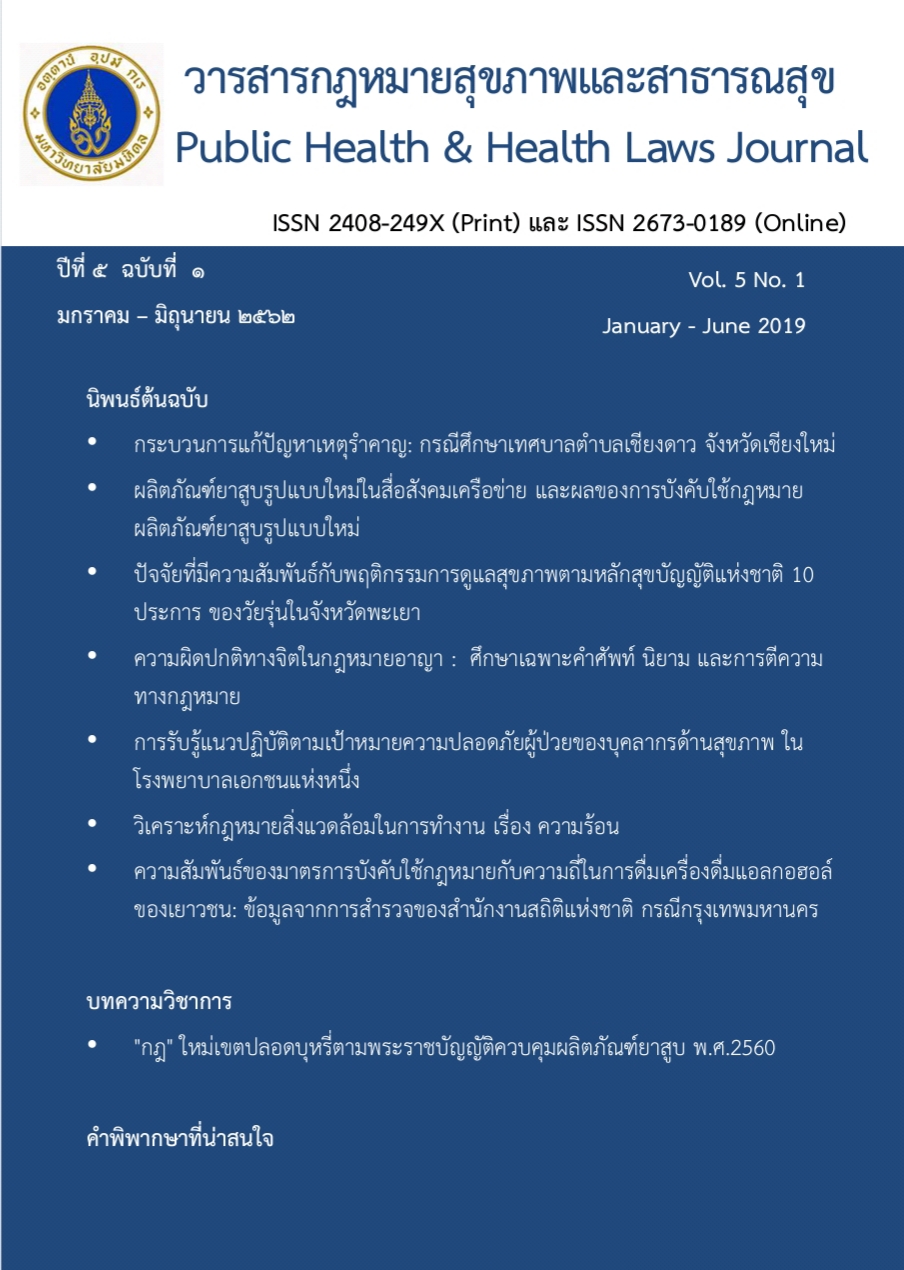Analysis of Work Environment Regulations on Heat
Keywords:
work environment regulation/ workload/ heat level/ heat protection suitAbstract
This research was aimed to analyze the ministerial regulations and the notifications of the Department of Labor Protection and Welfare for work environments which are heat, illumination, and noise. There were 8 analyzed issues; (1) the definition of an average for two hours of the heat measurement (2) the definition of light, moderate, and heavy work (3) specify the limit level of hot environment.
The results of the study revealed that (1) an average of heat measurement for two hours, if the first hour of heat measurement was higher than the limit and the second hour of measurement was lower than the limit, then the average of heat measurement from two hours may lower than the limit. This study suggested that the average should be from one hour instead of two hours. In case the heat is higher than the limit, the employee shall provide heat protection suit(s) but the regulation has not specified the type of heat protection suit. The regulation should review the definition of heat protection suit to be more specific. (2) The works load definition; light, moderate, and heavy was not accurate, this caused an error in work load assessment. The regulation should use the oxygen consumption method or heart beat method in relation with work load. (3) The limit of heat standards was higher than the international standards and was not found the Clothing Adjustment Factors (CAF). The regulation should be reviewed for the heat standard limit and the CAF.
References
กฎกระทรวงกำหนดมาตรฐานในการบริหาร จัดการ และดำเนินการด้านความปลอดภัย อาชีวอนามัยและ
สภาพแวดล้อมในการทำงานเกี่ยวกับความร้อน แสงสว่าง และเสียง พ.ศ. 2559 ราชกิจจานุเบกษา เล่ม 133 ตอนที่ 91 ก 17 ตุลาคม 2559 หน้า 4
ประกาศกรมสวัสดิการและคุ้มครองแรงงาน เรื่อง หลักเกณฑ์ วิธีการตรวจวัด และการวิเคราะห์สภาวะการทำงาน
เกี่ยวกับระดับความร้อน แสงสว่าง หรือเสียง รวมทั้งระยะเวลาและประเภทกิจการที่ต้องดำเนินการ ราช
กิจจานุเบกษา เล่ม 135 ตอนพิเศษ 57 ง 12 มีนาคม 2561 หน้า 11
American Conference of Governmental Industrial Hygienists (ACGIH), TLVs® and BEIs®: threshold
limit values for chemical substances and physical agents and bio¬logical exposure indices. Cincinnati, OH, 2017.
Belding HS (1971). Evaluation of stresses of exposure to heat. Pittsburgh: University of Pittsburgh.
Brenda J, W. Jon W, Kristin M, Aitor C, Jung-Hyun K, Nina T, Occupational Exposure to Heat and Hot
Environments. National Institute for Occupational Safety and Health (NIOSH) Revised Criteria 2016.
California Code of Regulations (2012) Title 8, section 3395. Heat illness prevention. Available at:
http://www.dir.ca.gov/Title8/3395.html. Accessed: 20 March 2012
Henshaw J. L. (2001). OSHA interpretation letter to Chip Terhorst: Acceptable methods to reduce
heat stress hazards in the workplace [OSHAct 5(a)(1)]. Cincinnati, OH: Occupational Safety and Health Administration. Available at: https://www.osha.gov/pls/oshaweb/owadisp.show_document?p_table=INTERPRETATIONS&p_id=24008
International Organization for Standardization. (1982). Hot environments: estimation of heat stress
on working man based on the WBGT index (ISO Standard No.7243).
International Organization for Standardization. (1990). Determination of metabolic rate (ISO
Standard No. 8996).
Meksawi S, An Accuracy of Work Heat Load Evaluation by Expert Judgment. A Thesis
Submitted in Partial Fulfillment of the Requirements for The Degree of Master of Science (Industrial Hygiene and Safety) Faculty of Graduate Studies Mahidol University 2006.
Minnesota Administrative Rules (2012) 52050110. Indoor workroom ventilation and temperature.
Available at https://www.revisor.mn.gov/rules/?id=5205.0110 Accessed: 09 December 2018.
Occupational Safety and Health Administration (OSHA). OSHA Technical Manual, Section 3; Chapter
Available at: https://www.osha.gov/dts/osta/otm/otm_iii/otm_iii_4.html. Accessed: 09
December 2018.
Downloads
Published
How to Cite
Issue
Section
License
Disclaimer and Copyright Notice
The content and information presented in articles published in the Journal of Law and Public Health Policy represent the opinions and sole responsibility of the respective authors. The editorial board does not necessarily agree with or assume any responsibility for the views expressed.
All articles, data, content, images, and other materials published in the Journal of Law and Public Health Policy are the intellectual property of the journal. Any individual or organization wishing to reproduce, distribute, or otherwise use the entirety or any part of such materials must provide proper citation.





